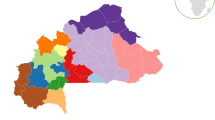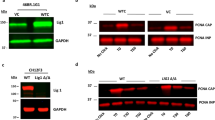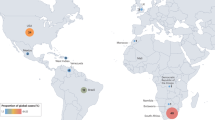Summary
Attempts to isolate the Huntington disease (HD) gene based on its position have been frustrated by apparently contradictory recombination events in HD pedigrees that have predicted two non-over-lapping candidate regions: 100 kb at the telomere of the short arm of chromosome 4, and a 2.2 Mb region located internally at 4p16.3. The proximal ___location is also supported by the detection of a linkage disequilibrium between HD and some restriction fragment length polymorphisms (RF-LPs) at the D4S95, D4S98, and D4S127 loci. In the present study, a proximal marker D4S95 showed tight linkage to the disease locus in Japanese pedigrees (Zmax=3.31,θ max=0.00), while distal markers D4S115 and D4S111 did not. Particularly, a two point linkage analysis between D4S111 and HD yielded a lod score −2.01 for θ=0.015. This result leads to the exclusion, as a possible region of localization of the HD gene, of more than 3 cM of the genome around D4S111 locus. At the same time our results favor aforementioned proximal ___location as a candidate ___location for the HD gene.
Similar content being viewed by others
Article PDF
References
Adam S, Theilmann J, Buetow K, Hedrick A, Collins C, Weber B, Huggins M, Hayden M (1991): Linkage disequilibrium and modification of risk for Huntington disease. Am J Hum Genet48: 595–603
Allitto BA, MacDonald ME, Bucan M, Richards J, Romano D, Whaley WL, Falcone B, Ianazzi J, Wexler NS, Wasmuth JJ, Collins FS, Lehrech H, Haines JL, Gusella JF (1991): Increased recombination adjacent to the Huntington disease-linked D4S10 marker. Genomics9: 104–12
Bates GP, MacDonald ME, Baxendale S, Youngman S, Lin C, Whaley WL, Wasmuth JJ, Gusella JF, Lehrach H (1991): Defined physical limits of the Huntington disease gene candidate region. Am J Hum Genet49: 7–16
Botstein D, White RL, Skolnick M, Davis RW (1980): Construction of a genetic linkage map using restriction fragment length polymorphisms. Am J Hum Genet32: 314–331
Bucan M, Zimmer M, Whaley WL, Poustka A, Youngman S, Allito BA, Ormondroyd E, Smith B, Pohl TM, MacDonald M, Bates GP, Richards J, Volinia S, Gilliam TC, Sedracek Z, Collins FS, Wasmuth JJ, Shaw DJ, Gusella JF, Frischauf A-M, Lehrach H (1990): Physical maps of 4p16.3, the area expected to contain the Huntington's disease mutation. Genomics6: 1–15
Conneally PM, Haines JL, Tanzi RE, Wexler NS, Penchaszadeh GK, Harper PS, Folstein SE, Cassiman JJ, Myers RH, Young AB, Hayden MR, Falek A, Tolosa ES, Crespi S, Maio LD, Holmgren G, Anvret M, Kanazawa I, Gusella JF (1989): Huntington disease: No evidence for locus heterogeneity. Genomics5: 304–308
Feinberg AP, Vogelstein B (1983): A technique for radiolabelling DNA restriction endonuclease fragments to high specific activity. Anal Biochem132: 6–13
Gilliam TC, Tanzi RE, Haines JL, Bonner TI, Faryniarz AG, Hobbs WJ, MacDonald ME, Cheng SV, Folstein SE, Conneally PM, Wexler NS, Gusella JF (1987): Localization of the Huntington's disease gene to a small segment of chromosome 4 flanked by D4S10 and the telomere. Cell50: 565–571
Gusella JF, Wexler NS, Conneally PM, Naylor SL, Anderson MAS, Tanzi RE, Watkins PC, Ottina K, Wallace MR, Sakuguti AY, Young AB, Shoulson I, Bonilla E, Martin JB (1983): A polymorphic DNA marker genetically linked to Hungtington's disease. Nature306: 234–238
Gusella JF, Tanzi RE, Bader PI, Phelan MC, Stevenson R, Hayden MR, Hofman KJ, Faryniarz AG, Gibbons K (1985): Deletion of the Huntington's disease linked G8(D4S10) locus in Wolf-Hirschhorn syndrome. Nature318:75–78
Hodge SE, Morton LA, Tideman S, Kidd KK, Spence MA (1979): Age-of-onset correction available for linkage analysis (LIPED). Am J Hum Genet31:761–762
Kanazawa I (1982): On the prevalence 47te of Huntington's disease in Ibaraki prefecture. Annual Report of the Research Committee of CNS Degenerative Disease 1983:151–156
Kanazawa I, Kondo I, Ikeda J, Ikeda T, Shizu Y, Yoshida M, Narabayashi H, Kuroda S, Tsunoda H, Mizuta E, Okuno Y, Sugawara K, Murata M, Takahashi M, Gusella JF (1990): Studies on DNA markers (D4S10 and D4S43/S127) genetically linked to Huntington's disease in Japanese families. Hum Genet85:257–260
Kunkel LH, Smith KD, Boyer SH, Borgaonkar HW, Rary JM (1977): Analysis of human Y-chromosome-specific reiterated DNA in chromosome variants. Proc Natl Acad Sci USA74:1245–1249
MacDonald ME, Anderson MA, Gilliam TC, Tranebjaerg L, Carpenter NJ, Magnenis E, Hayden MR (1987): A somatic cell hybrid panel for localizing DNA segments near the Huntington's disease gene. Genomics1:29–34
MacDonald ME, Cheng SV, Zimmer M, Haines JL, Poustka A, Allito B, Smith B, Whaley WL, Romano DM, Jagadeesh J, Myers RH, Lehrach H, Wasmuth J, Frieschauf AM, Gusella JF (1989a): Clustering of multi-allele DNA markers near the Huntington's disease gene. J Clin Invest84:1013–1016
MacDonald ME, Haines JL, Zimmer M, Cheng SV, Youngman S, Whaley WL, Wexler N, Bucan M, Allito BA, Smith B, Leavitt J, Poustka A, Harper P, Lehrach H, Wasmuth JJ, Frischauf AM, Gusella JF (1989b): Recombination events suggest potential sites for the Huntington's disease gene. Neuron3:183–190
MacDonald ME, Lin C, Srinidhi L, Bates G, Altherr M, Whaley WL, Lehrach H, Wasmuth J, Gusella JF (1991): Complex pattern of linkage disequilibrium in the Huntington disease region. Am J Med Genet49:723–734
MacDonald ME, Novelletto A, Lin C, Tagle D, Barnes G, Bates G, Taylor S, Allitto B, Altherr M, Myers R, Lehrach H, Collins FS, Wasmuth JJ, Frontali M, Gusella JF (1992): The Huntington's disease candidate region exhibits many different haplotypes. Nature Genet1:99–103
Morton NE (1955): Sequencial tests for the detection of linkage. Am J Hum Genet7:277–318
Nakamura Y, Leppert M, O'Connell P, Wolff R, Holm T, Culver M, Martin C, Fujimoto E, Hoff M, Kumlin E, White R (1987): Variable number of tandem repeat (VNTR) markers for human gene mapping. Science235:1616–1622
Nguyen C, Pontarotti P, Birnbaum D, Chimini G, Ray JA, Mattei JF, Jordan BR (1987): Large scale physical mapping in teh q27 region of the human X chromosome: The coagulation factor IX gene and the mcf.2 transforming sequence are separated by at most 270 kilobase pairs and are surrounded by several “HTF islands.” EMBO J6:3285–3289
Ott J (1976): A computer program for linkage analysis of general human pedigrees. Am J Hum Genet28:528–529
Pohl TM, Zimmer M, MacDonald ME, Smith B, Bucan M, Poustka A, Volinia S, Searle S, Zehetner G, Wasmuth JJ, Gusella JF, Lehrach H, Frischauf A-M (1988): Construction of aNot I linking library and isolation of new markers close to the Huntington's disease gene. Nucleic Acids Res16:9185–9198
Poustka A, Pohl TM, Barlow DP, Frischauf A-M, Lehrach H (1987): Construction and use of human chromosome jumping library fromNot I-digested DNA. Nature325:353–355
Robbins C, Theilmann J, Youngman S, Haines J, Altherr MJ, Harper PS, Payne C, Junker A, Wasmuth J, Hayden MR (1989): Evidence from family studies that the gene causing Huntington disease is telomeric to D4S95 and D4S90. Am J Hum Genet44:422–425
Smith B, Skarecky D, Bengtsson U, Magenis RE, Carpenter N, Wasmuth JJ (1988): Isolation of DNA markers in the direction of the Huntington disease gene from the G8 locus. Am J Hum Genet42:335–344
Snell RG, Lazarou LP, Youngman S, Quarrell O, Wasmuth JJ, Shaw DJ, Harper PS (1989): Linkage disequilibrium in Huntington's disease: An improved localisation for the gene. J Med Genet26:673–675
Snell RG, Thompson LM, Tagle DA, Holloway TL, Barnes G, Harley HG, Sandkuijil LA, MacDonald ME, Collins FS, Gusella JF (1992): A recombination event that redifines the Huntington disease region. Am J Hum Genet51:357–362
The Huntington's Disease Collaborative Research Group (1992): A novel gene containing a trinucleotide repeat that is expanded and unstable on Huntington's disease chromosome. Cell72:971–983
Theilmann J, Kanani S, Shiang R, Robbins C, Quarrell O, Huuggins M, Hedrick A, Weber B, Collins C, Wasmuth JJ, Buetow KH, Murray JC, Hayden MR (1989): Non-random association between alleles detected at D4S95 and D4S98 and the Huntington's disease gene. J Med Genet26:676–681
Wasmuth JJ, Hewitt J, Smith B, Allard D, Haines JL, Skarecky D, Partlow E, Hayden MR (1988): A highly polymorphic locus very tightly linked to the Huntington's disease gene. Nature332: 734–736
Whaley WL, Michiels F, MacDonald ME, Romano D, Zimmer M, Smith B, Leavin J, Bucan M, Haines JL, Gillium TC, Zehetner G, Smith C, Cantor CR, Frischauf A-M, Wasmuth JJ, Lehrach H, Gusella JF (1988): Mapping of D4S98/S114/S113 confines the Huntington's defect to a reduced physical region at the telomere of chromosome 4. Nucleic Acids Res16: 11769–11780
Whaley WL, Bates GP, Novelletto A, Sedlacek Z, Cheng S, Romano D, Ormondroyd E, Allitto B, Lin C, Youngman S, Baxendale S, Bucan M, Wasmuth JJ, Wexler N, Frontali M, Frischauf AM, Lehrach H, MacDonald ME, Gusella JF (1991): Mapping of cosmid clones in Huntington's disease region of chromosome 4. Somat Cell Mol Genet17: 83–91
Youngman S, Sarfarazi M, Bucan M, MacDonald M, Smith B, Zimmer M, Gilliam C, Frischauf A-M, Wasmuch JJ, Gusella JF, Lehrach H, Harper PS, Shaw DJ (1989): A new DNA marker (D4S90) is located terminally on the short arm of chromosome 4, close to the Huntington disease gene. Genomics5:802–809
Author information
Authors and Affiliations
Rights and permissions
About this article
Cite this article
Watanabe, M., Kondo, I., Nissato, S. et al. A linkage study with DNA markers (D4S95, D4S115, and D4S111) in Japanese Huntington disease families. Jap J Human Genet 38, 193–201 (1993). https://doi.org/10.1007/BF01883710
Received:
Accepted:
Published:
Issue Date:
DOI: https://doi.org/10.1007/BF01883710



